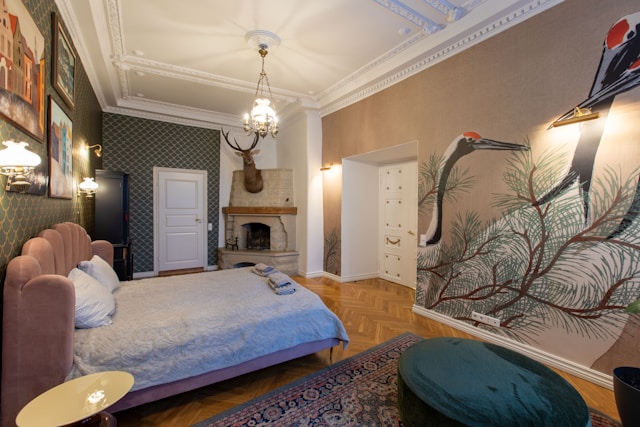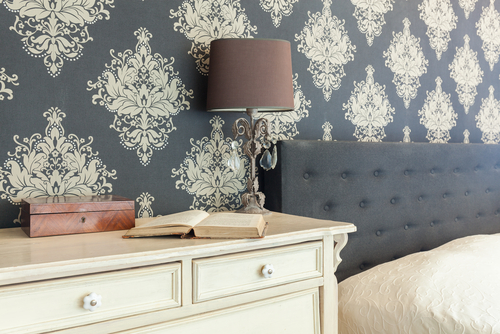Despite many people considering paint to be an easier alternative to wallpaper, this decorative medium has many advantages over paint, making it an excellent choice for those seeking to add depth, texture, and character to a room. Whether you’re looking to create a bold statement or a subtle backdrop, wallpaper offers endless possibilities.

Wallpaper design is extremely versatile
Wallpaper can be found in an almost endless number of designs, making it possible to find exactly the design and colour to revitalise your space. For super-fussy individuals or those looking for something bespoke and tailor-made to their specific design – for instance, as part of a brand identity in the corporate or commercial spheres – some companies can make this a reality. It is not necessary to cover the area completely. Sometimes a simple accent wall can make a huge difference, which is where specialist printing services can come to the rescue.
Wallpaper is not a “one-size-fits-all” in its application
Wallpaper has a wide variety of different offerings. Even today, you can find wallpaper in traditional florals, choose modern geometrics, or opt for nature-inspired patterns. Even so, wallpaper is also available in colours and patterns which offer a subtle background with gentle washed-out colours, a fabric-like texture, or simple embossing which appeals to both the visual and tactile senses. Wallpaper thus provides texture which adds dimension to walls that paint cannot replicate. High-quality wallpaper is also long-lasting and durable. When properly installed, it can last up to 15 years or more, making it a cost-effective option in the long run. High-end wallpaper is also washable, which can be beneficial for households with children or high-traffic areas. One of the most important advantages of wallpaper over painted surfaces is its ability to hide imperfections in the wall surfaces, such as small dents, cracks or stains which a light-coloured paint will not conceal. Interestingly enough, a bold-print wallpaper is very useful in disguising sections of a wall which are not straight and which, annoyingly, draw the eye and create a visual disturbance. Covering a not-so-straight section of the wall with bold wallpaper will give the viewer a different perspective and distract from the imperfection almost seamlessly. Paint alone will not achieve this effect but will perhaps only exacerbate the problem.
Types of Wallpaper
There are several types of wallpaper, each with its particular benefits. Choosing the right one depends on the room and your needs. I have listed a few below, or an interior designer may also have some ideas to assist in the overall design and purpose of the space.
Vinyl Wallpaper: One of the most popular options, vinyl wallpaper is durable and easy to clean, making it ideal for kitchens, bathrooms, and other high-traffic areas. It’s moisture-resistant and can stand up to heavy cleaning and scrubbing, making it highly practical.
Non-woven Wallpaper: Made from a blend of natural and synthetic fibres, non-woven wallpaper is tear-resistant and breathable. It’s easier to apply and remove than traditional paper-based wallpaper, making it easy for DIY projects.
Textile Wallpaper: This is made from natural or synthetic fabrics like silk, linen, or velvet, creating a luxurious, textured finish. Whilst beautiful, it can be more difficult to clean and maintain, making it best suited for low-traffic, decorative areas like bedrooms or formal dining rooms. If you are using this type of wallpaper, you may also be using the services of an interior designer to create the formal appeal you are looking for.
Peel-and-Stick Wallpaper: This is an easy-to-apply, temporary option that’s perfect for renters or those who want to experiment with wallpaper without committing to a permanent installation. Peel-and-stick wallpaper can be easily removed without damaging the walls.
Grass-cloth Wallpaper: Made from natural materials like bamboo, jute, or grass, grass-cloth wallpaper adds an organic, textured element to a room. Although extremely attractive, it can be difficult to clean and is not recommended for high-moisture areas like bathrooms, high-traffic areas and children’s rooms.
Scenic Murals: Large-scale murals depicting landscapes, cityscapes, nature scenes, seascapes, or abstract art can transform a plain wall into a stunning focal point. You will often find the use of such murals in public waiting areas such as hospitals or medical waiting rooms. This may extend to murals spanning panels along long corridor walls, making them interesting and cheerful, and they break up long uninteresting spaces very effectively.
How to Choose the Right Wallpaper for any Area
The right wallpaper can completely change the atmosphere and appeal of a room. Here are a few tips on how to make the best choice:
Consider the purpose and use of the room: Bold, vibrant patterns can work well in social spaces like living rooms or dining areas, where they can create a focal point. In contrast, softer, more subdued patterns or textures are better suited for bedrooms or offices to create a calming environment. The type of wallpaper you choose should be suited to the space; for instance, fabric or grass-cloth may need more delicate cleaning approaches like dusting or vacuuming, whilst vinyl can easily be cleaned with a damp cloth. Always avoid using harsh chemicals that could damage the finish.
Pattern size: Large patterns tend to make a room feel cosy and can alleviate the bare look of large, open spaces, whilst smaller patterns can create a sense of space. For smaller rooms, consider wallpaper with a delicate, detailed design, whereas larger rooms can accommodate bold, oversized patterns that may overwhelm smaller spaces and make them feel stuffy or claustrophobic.
Lighting: Light plays a crucial role in how wallpaper looks in a room. Good advice is to test samples to see how the colour and pattern display in different lighting conditions. What looks warm and inviting under artificial light may be overwhelming and depressing in normal lighting during the day.
There is more to wallpaper than meets the eye
Wallpaper is more than just a decorative element; it’s a powerful tool for transforming spaces and can be a highly decorative asset in interior renovation projects. With a wide range of designs and styles available, it offers endless opportunities to express personal and professional aims and creativity. Whether you’re redecorating a single room, your entire home, or creating an inviting and comfortable customer waiting area, wallpaper can help you achieve a perfect look. For complex patterns or large areas, consider contracting a wallpaper specialist to ensure a flawless finish, durability and a decorative element which draws the eye for the right reasons. To find interior designers or wallpaper services, search Uptasker’s content and blog articles.
